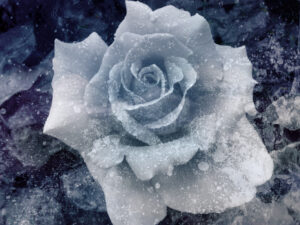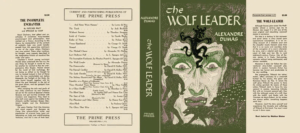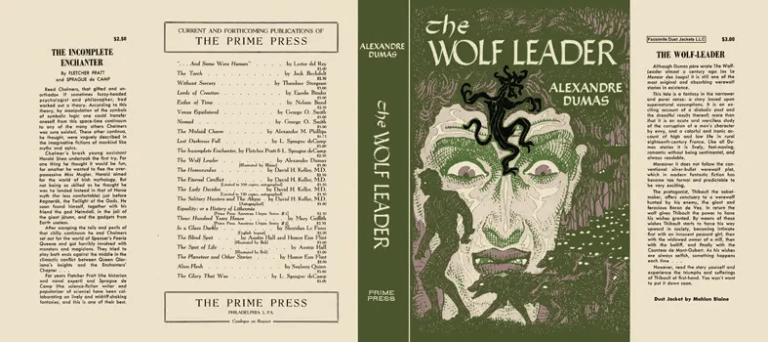About a thousand feet below the summit of the Untersberg, and not very far from the top of one of its spurs, that reaches out into the valley through which runs the limpid stream coming from the renowned lake called the “Koenigsee,” there is a spacious cave, within an almost perpendicular slope of rocks, several hundred feet in height. This cave or hole, called the “Dragon’s Den,” is large enough for affording shelter to a whole herd of cattle, and high enough so that a good-sized church, steeple and all, might be put therein. Its roof is formed by an overhanging rock (as is shown in our picture), and the hole extends like a tunnel from one side of the hill to the other; so that if seen from below it appears like an archway through which the sky and the stars on the other side may be seen.
This den is said to have been inhabited in ancient times by a villainous dragon of a very peculiar kind, having no conscience, reason, or common sense, but being exceedingly selfish. His greatest pleasure was to dissect and analyse everything, and to destroy all that was of an ideal nature; to tear the clothes away from everything exalted and beautiful for the purpose of exposing bare facts. These he liked so well, that he imagined the bones of every creature were its only essential parts; so he tore the flesh of his victims away and devoured their bones. From the altitude of his den he would overlook both sides of the hill, and whenever he saw a pretty maiden wandering among the rocks in search of the Alpine rose or the Edelweiss, he would pounce upon her, drag her to his den, dissect her, and strip her of all flesh, and devour the bones piece by piece. It is said that later on the dragon emigrated into the valley, but his den was selected by the committee for the investigation concerning the non-existence of gnomes.
Before we proceed further, it will be necessary to introduce the reader to our friends. There was, first of all, Professor Thomas Cracker, a member of nearly all scientific societies in the world, a great sceptic, who, by a long course of scientifically training his imagination, had acquired such a degree of scientific scepticism that he always knew everything without taking the trouble of looking at it. There was no fact in Nature for which he had not invented a theory; and if the theory did not fit it, so much the worse for the facts. He had become celebrated; because, owing to his superior sagacity, and after years of persevering study, he had succeeded in discovering that a certain book entitled “Little Alice in Wonderland,” was only a fable, not based upon historical facts, and whose object was to bamboozle the ignorant and take in unwary and gullible people. Owing to the great merit obtained by this work the honour and title of a member of the Academy was bestowed upon him.
Mr Cracker’s father had been the keeper of a variety shop, and was in the habit of ignoring and treating with contempt everything that was not of his own manufacture or kept in his shop. Nevertheless, among the good articles which he kept for sale, there were many things that had gone out of fashion. These he used to fit up in a new style, varnish and paint them over, give them new labels with modern names, and advertise them as something brand new. Thus he did a good trade and gained a reputation.
Professor Cracker, junior, resembled his father to a dot, only he traded in less tangible goods. He also was in the habit of ignoring and treating with contempt everything that did not agree with the theories that were manufactured by himself or his colleagues; nevertheless there were among his articles of creed certain doctrines taught centuries ago, but having gone out of fashion. These he used to take down from the garret where they had been forgotten, dress them up in modern style, varnish them over with modern expressions, label them with newly invented names, and advertise them as brand-new discoveries, or goods of his own invention. In this way Professor Cracker traded in science and gained a reputation.
The next was the Reverend Jeremiah Stiffbone, a clergyman, who had received from his congregation a liberal amount of money to enable him to travel in search of the truth that could not be found at home. Mr Stiffbone was well versed in all sorts of authorities, and able to quote almost any number of books in support of almost any opinion, for he knew the contents of many scientific and religious writings,—that is to say, he knew what was written therein; but as to his knowledge in regard to the subjects themselves, it would be difficult to decide what it was; for he one day believed in this and the next day in another author’s veracity, and the one into whom he put his faith was for the time being to him the only infallible one. Thus he stumbled along upon the path of wisdom, falling from one opinion into another like a person in a state of intoxication. It should not be supposed, however, that Jeremiah loved this state of uncertainty and wavering. What he wanted, above all, was to establish a scientific and religious system that could be fully depended on as being true and reliable, and containing articles and scientific doctrines which everyone would have to accept as true, and go to sleep quietly, being firmly convinced that the opinions therein were the final dictates of science, incontrovertible, not subject to improvement, and fully correct.
As to the external appearance of the above-named two gentlemen, Professor Cracker was of short stature, thickly set, with a rubicund face, smoothly shaven, except a pair of grey side-whiskers. His little eyes continually wandered restlessly from one object to another, his arms were unusually long, but his legs short and bow-shaped, and all this somehow contributed to give him the appearance of a Mandril (Cynocephalus Maimon), as may be said without giving offence to the Professor; for he was himself firmly of the opinion that the whole of man had descended[34] from the ape. He even looked with satisfaction upon his long line of ancestors, and prided himself on having become somehow superior to them in the art of reasoning, if not in bodily strength.
As to the Reverend Stiffbone, he seemed the reverse of Professor Cracker. He was thin and tall, looking like a collection of bones of some antediluvian bird. His features were sharp, his head almost bald, and his mouth wide, while his chin and nose were long and protruding, as if they were trying to meet each other. Upon his nose he wore a pair of green goggles of great size, causing him to appear not unlike an owl; but his nose and chin gave him a resemblance to one of the well-known wooden nut-crackers, which are manufactured in the city of Nuremberg, and are the delight of the children all over the world.
Finally, there was Moses Abraham Scalawag, Esq., the commercial business manager of the expedition. His external appearance went to show that he was not much of an idealist, but preferred the good and material things of this life, and had no aversion to a certain kind in spirits. Although he denounced the belief in hobgoblins, ghosts, gnomes, etc., as a degraded superstition, he somehow thought that, if the story of Burkhart von Tollenstein were true, it might be worth the while to investigate the financial condition of the gnomes in the Untersberg.
We were accompanied by a guide, carrying our provisions and scientific instruments. This guide was a direct descendant of the reputed Lazarus Gitschner, who in the year 1529 spent ten days among the gnomes in the Untersberg. We attempted to draw him out, but the guide would not reveal what his ancestor had seen during that visit; nor is this surprising, for Lazarus himself never revealed it to anybody except to the priest in the confessional. All that has become known about it is, that he came out of the Untersberg a man entirely changed from what he was before he went in, and the priest also, after hearing the confession, became very much changed himself, even so that he left off playing ninepins on Sunday morning, led a retired life, and died not long afterwards in the odour of sanctity.
Bright was the day, and the earth looked refreshed from the morning dew that still rested upon the daffodils and ferns, where it glittered in the light of the sun like so many small diamonds. The air was fragrant from the odour of pines and wild thyme, and the breeze carried up from the valley an aroma of new-mown hay. Peacefully grazed the goats upon the sides of a hill, from which rushed a small cataract in a thousand cascades, while an air of tranquillity and solemnity rested upon the scene below, interrupted only by the tolling of the bell in the distant village church, which sounded harmoniously into the solitude.
Of all this, however, our members of the committee saw, heard, smelt, and knew nothing; for each was absorbed in his own thoughts. Professor Cracker moved slowly on, carrying his wig on his walking-stick over his shoulder, and revelling in the anticipation of the glory which the annihilation of the gnome theory would bring upon him. The Rev. Stiffbone’s long coat-tails fluttered in the wind as he marched on, taking long strides upon the uneven path, and his thoughts were absorbed in the prospect of being able to add another incontrovertible doctrine in regard to the non-existing of gnomes to his Bible of Science. Mr Scalawag wobbled along as well as he could, thinking nothing particular, but stopping frequently and wiping the sweat from his brow. At last he exclaimed:
“Confound these gnomes! Is it worth the while to climb up to that den and waste our valuable time in disproving that such animals exist?”
To this the Reverend Stiffbone replied:
“Gnomes are not animals, but imaginary beings. Theophrastus Paracelsus describes them as being intellectual forces in nature, whatever that may mean. They are about six inches in height, but able to change and to elongate their bodies.”
“But how can you determine their height,” asked Mr Scalawag, “if they are merely imaginary? You may just as well imagine them to be a thousand feet, if you try.”
“Rot!” interrupted Professor Cracker; for that was his favourite impression whenever anything was mentioned that was unknown to him. “Rot! there are no such things as intelligent forces of nature, neither imaginary ones nor others. This degrading superstition has now lasted long enough, and this day will make an end to such vagaries.”
“Are you then firmly convinced,” asked Mr Scalawag, rather dejectedly, “that the treasures of the gnomes in the Untersberg do not exist?”
“They exist only in the imagination of fools,” replied the Professor. “There can be no such thing as a spirit, as I shall demonstrate to you to-day by means of my new spiritoscope.”
“It is strange,” now remarked the Rev. Stiffbone, “that there are still some respectable authorities favouring such a superstitious belief. Even the Bible mentions the existence of spirits in more than one instance.”
“Rot!” replied the Professor. “There is no theory so absurd that it may not find admirers among otherwise intelligent people. Only think of the many fools who imagine it to be possible to make cars that are pulled by steam!”
“Do you then believe it to be absolutely impossible to make railways?” asked Mr Scalawag.
“Railways!” sneeringly exclaimed Cracker. “Rot! No man in his sane senses would ever think of such a thing. Steam can blow; but it cannot pull cars; if a steam-engine were invented, it would scald everybody to death. As to those eccentric and fanatical people who now fancy it possible to make a railway between Manchester and Liverpool, I have only to say that we, the scientists of this century, decline to waste our time in examining such wild and extravagant schemes. Even if the tales told in some of the newspapers were true, instead of being deplorable vagaries, and if it were possible to invent such an engine, it would not interest us, for surely nobody would be insane enough to trust his life and his safety to an engine going at the terrible speed of sixteen miles an hour! No, my dear sir! To make a railway is as impossible as that stones should fall from heaven; the reason of which impossibility the Academy of Science has pointed out, namely, because there are no stones in the sky.”
It may be observed that this conversation took place before the time when meteors were known and railways in action; at the present time such a display of scientific ignorance would of course be impossible.
“Suppose,” said the Rev. Stiffbone, “we admit for argument’s sake that a railway could be made on a level plain. What would they do if they were to come to a mountain? They would have to dig a hole through it, pass through it in the dark, and coming out at the other end the passengers would suddenly emerge into the light. This sudden change would undoubtedly strike them blind.”
“Undoubtedly it would,” added Professor Cracker, “unless they were to wear travelling-goggles for protection. You may however rest assured that, if railways could be made, we would have discovered it long ago, and the same may be said in regard to gnomes, ghosts, spirits, or intelligent forces of any kind. If there were such things we would know it.”
“How is it then possible,” I asked, “that the ancient philosophers believed such things?”
“To a layman like you,” answered the Professor, “such a question may be pardoned. The ancient philosophers were fools; they did not know as much as one of our schoolboys knows to-day. As to Lord Lytton, Goethe, and other more modern writers who spoke of such things, they only did so because they loved to make jokes for the amusement of the wise, and to have some fun at the expense of the gullible. We know that spirit without matter does not exist. Matter is visible; consequently the spirits would have to possess visible forms. We also know that no kind of living beings can exist within solid rocks, where they would be without water and air, and finally, if there were any intelligent forces in nature, they would know the importance of coming forward and proving their existence to men of science.”
I remarked that a belief in gnomes was quite common in this country, and asked whether this could be explained.
“Ridiculously easy!” said the Professor. “The sources of error are—inherited idiosyncrasies; a want of scientific training in making observations; subjective, objective, and epidemic hallucinations; credulity, hysteria, suggestion, dreams, hypnotism, post-hypnotic auto-suggestion, and so forth.”
“Nevertheless,” I objected, “there are those who have been touched by gnomes, have seen and conversed with them, received tangible objects from them.”
“Rot!” replied Cracker. “It is all due to wilful deception, humbug, swindle, trumpery, fraud, plagiarism, coincidence, telepathic impact, thought-transfer, unconscious cerebration, mediumship, sympathetic association of ideas, etc. Only recently I have discovered, after making a long research and consulting many authorities, that the accounts given in Gulliver’s Travels were not based upon historical facts, but are only the products of the imagination of the author, who for thus imposing upon the credulity of the public, must be regarded as being one of the greatest cheats of his age. Fetch me a spirit or gnome, and let me dissect it to see of what it is made. Unless you do so, I say that it is nothing but rot, the product of the disordered fancy of a scientifically untrained brain.”
I did not quite agree with Cracker’s views, and I therefore said: “I believe that there are still people capable of telling a pigtail from a broomstick without dissecting it and having it certified to by a professor of science.”
Cracker and Stiffbone exchanged an ominous look.
“This,” said Stiffbone, “comes from the increased disrespect for the authorities. Nowadays everybody imagines that he has a right to think and say what he pleases. It is time that a law ought to be made punishing heresy in science, as it used to be punished in regard to religion. Not long ago I heard a new heresy preached about what they call ‘conservation of energy.’ Men ought not to be permitted to go about and poison the minds of the public by spreading erroneous scientific doctrines. We absolutely need a Bible of Science, stating exactly what scientific beliefs the people are to accept.”
“Such a book,” answered the Professor, “would be of the greatest benefit to the world, and prevent the injurious and misleading self-thinking done by laymen and ignorant tramps. What business have the common people to do their own thinking? No one ever attempts to make his own shoes or clothes, but leaves this to his shoemaker or tailor, who can do it much better, cheaper and quicker than he could do it himself. Why not apply the same system to deciding scientific or religious questions? Let the thinking in regard to such things be left to those who are trained and entitled to it.”
With these views the Rev. Stiffbone fully agreed. “Science,” he said, “ought to be left to the scientists, religion to the clergy, morality to the police, medicine to the physicians, money matters to bankers, and ideal things to legally appointed idealists. This would enable the people to give more attention to their own material interests. Instead of thinking about things which bring them no profit, they might employ their time for useful things, such as the raising of hogs. Religion ought not to be neglected, for the fear of the devil is the security of the Church; but one authentic sermon printed and posted every Sunday in public places would save the employment of an army of preachers, and moreover secure conformity to the doctrines taught everywhere. If the people must have music, one or two organ-grinders would be enough for a town of no more than a thousand inhabitants; if they wanted poetry, one well-trained and diplomatised verse-maker could supply the whole country.”
“These questions,” said M. Scalawag, Esq., “deserve the most careful consideration. Time is money. The struggle for existence is the first law among all beings; the survival of the fittest its necessary result. Let everyone take as much care as he can of his own interest, and leave it to those who are appointed for that purpose to look out for the rest.”
“We are appointed for that,” exclaimed Professor Cracker, “and we will attend to it. I have just discovered a new system of hypnotism by means of which large crowds can be hypnotised at once. Instead of sending the children to school, we will hypnotise into their heads all that we want them to know, and cause them to post-hypnotically forget all which we do not wish them to remember. Thus we will be the kings of the world, and all mankind will dance as we pull the strings!”
While carrying on these discussions we arrived at the “Dragon’s Den,” where our investigations were to begin. The place showed no indication of the presence of spirit; there was nothing dismal about it; on the contrary, an air of peace seemed to rest upon the scene. At the entrance of the cave there was a wild rosebush of considerable size and some Alpine flowers, among which I noticed the Larkspur and Belladonna. The walls consisted of marble rocks, exhibiting a variety of colours, and were covered in some places with mosses and ferns. In a shady corner there was still a remnant of snow, resembling a miniature glacier, and rendering the air cool and pleasant. The two openings at the sides offered a magnificent view.
The guide—who had remained a little behind, as his movements were greatly impeded by the legs of Professor Cracker’s spiritoscope, which he carried—now arrived with his bag of provisions, and unpacked his treasures. Cold meats, poultry and cheese, ham and eggs, butter and bread, made their appearance, and were soon disposed of by the committee. Beer and wine had not been forgotten, and Professor Cracker, filling his glass with champagne, lifted it up and offered a toast, “to the annihilation of the gnomes;” which was followed by another toast, pronounced by Jeremiah Stiffbone, “to Professor Cracker, the king of science, and inventor of the spiritoscope,” while Mr Scalawag, in offering his sentiments, said he hoped to find some of the treasures of the Untersberg.
After the refreshments were taken, the investigations began. To begin with, the committee carefully examined the rocks and walls and every nook and corner of the “Dragon’s Den” for the purpose of convincing themselves that there was no place where anybody might hide himself and play a practical joke upon the investigators. They measured the size of the rocks, and made sure of their solidity and the entire absence of any subterranean caves or holes. The floor was found to be perfectly solid, and no gnomes were to be seen. Thereupon they carefully noted the hour and the minute, as is always necessary on such occasions, and evidence was taken that the sky was clear. The direction of the wind was determined with great accuracy, and found to be E.N.E.; the temperature was taken and the various thermometers indicated—25° Celsius, 20° Reaumur, and 77° Fahrenheit; the barometer showed an elevation of 5800 feet above the sea and a medium atmospheric pressure. No gnome or spirit of any kind appeared upon the scene, nor was there to be found anything whatever of a spiritual character. After all the necessary preparations were made Professor Cracker produced his spiritoscope, whose description we are permitted to give for the benefit of all psychical researchers; and as a boon to the whole of mankind:
Dr Cracker’s Spiritoscope.
This ingeniously constructed and very simple, although somewhat ponderous instrument was the original invention of Professor Cracker, and enabled him, instead of directly looking at an object, to behold and examine it by means of a series of reflections produced by four scientifically arranged mirrors bent towards each other at angles of 45 degrees.








No Comments